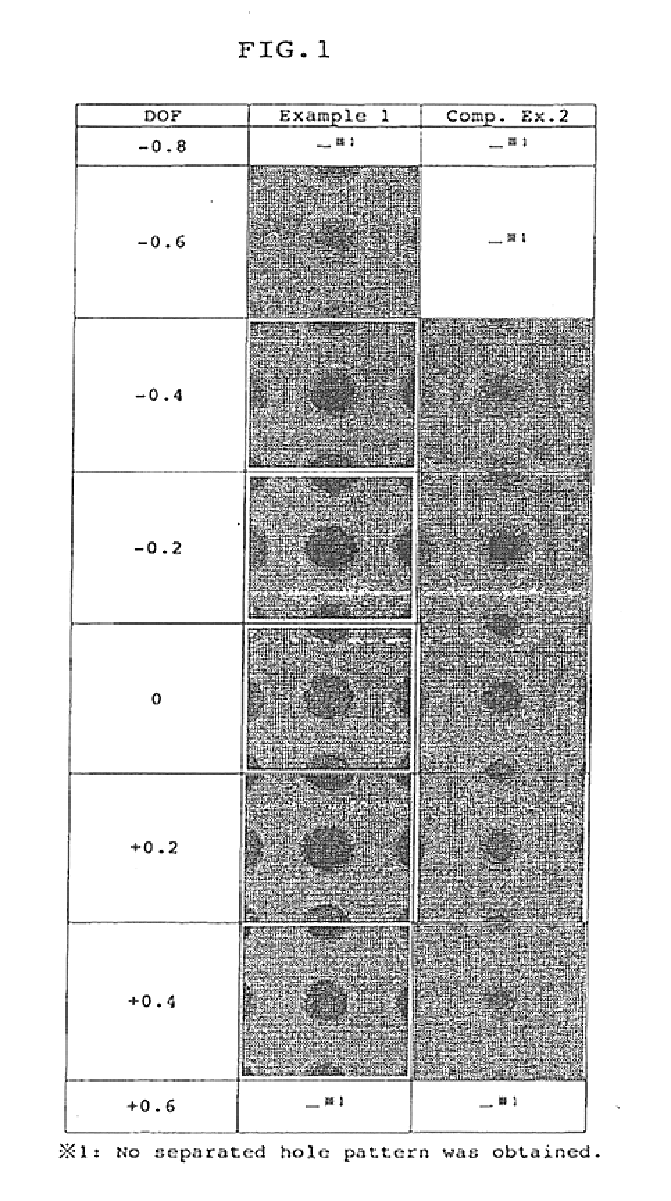Positive photoresist composition
a composition and photoresist technology, applied in the field of positive photoresist compositions, can solve the problems of etching failure and interconnection failure, inability to form satisfactory hole patterns, and failure to form separated patterns, and achieve excellent sensitivity, definition and focal depth range properties.
- Summary
- Abstract
- Description
- Claims
- Application Information
AI Technical Summary
Benefits of technology
Problems solved by technology
Method used
Image
Examples
examples
The present invention will be further illustrated in detail with reference to several examples and comparative examples below which are not intended to limit the scope of the invention.
The properties of the resulting positive photoresist compositions were determined according to the following methods, and the results are shown in Table 2.
(1) Sensitivity
A sample was applied onto a silicon wafer carrying an antireflection film (available from Tokyo Ohka Kogyo Co., Ltd. under the trade name of SWK-T5 D60) using a spinner and was dried on a hot plate at 90° C. for 90 sec. to form a resist film 0.84 μm thick. The resist film was then irradiated with light through a halftone mask corresponding to a hole diameter of 0.34 μm and having a duty ratio of 0.8 and a pitch (an interval between the centers of the individual holes) of 0.61 μm for an increasing period from 0.5 sec. at intervals of 0.03 sec. using a reducing-type projection aligner NSR-2205i 14E (available from Nikon Corporation, Jap...
synthesis example
Synthesis of Novolak Resin
1. Control of Molecular Weight (Mw) and Molecular Weight Distribution (Mw / Mn) by Fractionation Procedure
A polycondensation product was obtained by dehydration condensation reaction of m-cresol, p-cresol and 2,3,5-trimethylphenol (molar ratio=35:40:25) with formaldehyde. A total of 125 g of the polycondensation product was placed in a 2-litter beaker and was dissolved in 920 g of methanol using a stirrer.
Next, 313 g of pure water was added to the solution to thereby form a precipitate, the precipitate was taken out from the beaker and thereby yielded a polycondensation product (x) having controlled molecular weight and molecular weight distribution (Mw=4200, Mw / Mn=2.3).
The polycondensation product contained 0.49% by weight of phenolic monomers and 2.72% by weight of dimers as determined by GPC analysis.
In this procedure, GPC analysis was performed using the following systems under following conditions.
GPC Measuring Method for Mw and Mw / Mn Determination(1) A ...
example 1
Ingredient (A) (alkali-soluble novolak resin): The novolak resin a1 prepared in Synthesis Example as the solution
Ingredient (B) (quinonediazide ester): The following compound b1
Ingredient (C) (sensitizer): The following compound c1
In 270 parts by weight of a solvent mixture of ethyl lactate and butyl acetate (mixing ratio of 9:1), 100 parts by weight of the ingredient (A) (corresponding to 340 g of the solution), 3.9 parts by weight of the ingredient (B) and 30 parts by weight of the ingredient (C) were dissolved, the resulting mixture was filtrated through a membrane filter having a pore size of 0.1 to 0.2 μm and thereby yielded a positive photoresist composition.
PUM
| Property | Measurement | Unit |
|---|---|---|
| molecular weight distribution | aaaaa | aaaaa |
| molecular weight distribution | aaaaa | aaaaa |
| hole diameter | aaaaa | aaaaa |
Abstract
Description
Claims
Application Information
 Login to View More
Login to View More - R&D
- Intellectual Property
- Life Sciences
- Materials
- Tech Scout
- Unparalleled Data Quality
- Higher Quality Content
- 60% Fewer Hallucinations
Browse by: Latest US Patents, China's latest patents, Technical Efficacy Thesaurus, Application Domain, Technology Topic, Popular Technical Reports.
© 2025 PatSnap. All rights reserved.Legal|Privacy policy|Modern Slavery Act Transparency Statement|Sitemap|About US| Contact US: help@patsnap.com



